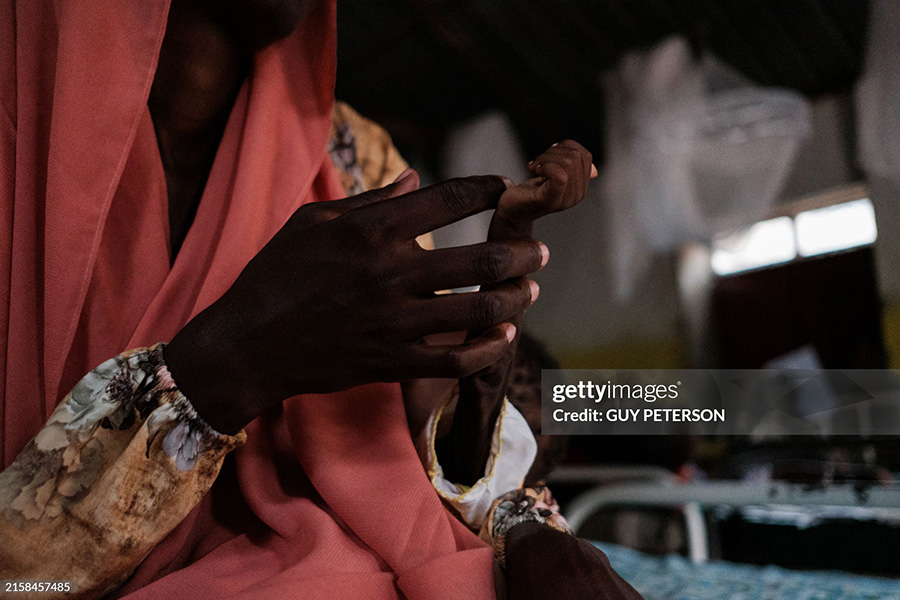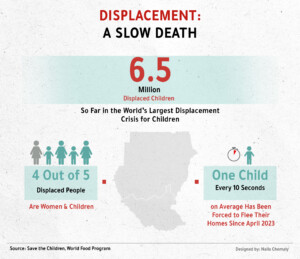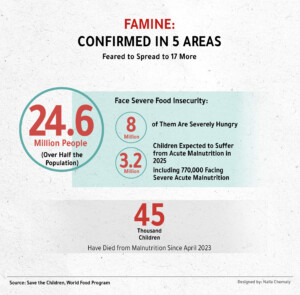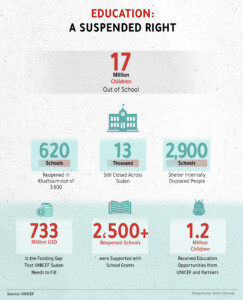We Communicate For Happy Children
 Sudan: Forgotten Childhood and Lost Rights
Sudan: Forgotten Childhood and Lost Rights 
29 May 2025
On April 15, 2025, the brutal war in Sudan entered its third year. The sequence of events over the past few months demonstrates the rapid shift in the geographic control of the belligerents. However, the humanitarian situation for families and children has deteriorated. A tragedy of this magnitude requires massive media coverage in addition to significant popular and political mobilization. Yet, its presence in the global discourse is almost absent thus extremely far from the severity of the calamity.
Over two years of suffering for children, mothers, pregnant women, and their caregivers with reports of widespread violations of international humanitarian law. Thousands have been killed, injured, and missing, mostly women and children. Famine has consumed some areas, while others are on the verge of famine. Approximately 45,000 children have died from malnutrition until mid-April 2025. So far, multiple forced displacements have affected more than 12 million civilians, including more than 8 million internally displaced persons. Rape and other forms of sexual violence have not spared even infants as young as one year old. Children are out of school. Homes, health facilities, markets, and civilian infrastructure are destroyed. Essential commodities are in short supply and expensive. Environmental degradation and waste are accumulating. A medical sector is on the brink of collapse, with lack of medical equipment and clean drinking water, leaving millions of children vulnerable to diseases, including cholera. Aid is being mishandled, and humanitarian workers, journalists, and human rights defenders are being targeted and attacked.
In short, Sudan is currently experiencing the worst humanitarian crisis in the world. Thirty million people, nearly half of whom are children, are in need of emergency life-saving assistance. Save the Children summarized the situation of children through its Country Director in Sudan as follows:
“For two years, conflict and widespread violence in Sudan have caused immense suffering for children. This has become the world’s largest displacement crisis for children, but despite the urgent need, the crisis in Sudan remains largely underreported, and the world is not taking notice”.
Unrecorded death
The major dilemma in Sudan is the lack of accurate data, the spread of misinformation, and the inability to verify data accuracy through neutral parties, especially journalists. According to the Committee to Protect Journalists, Sudan was one of the most dangerous countries in the world for practicing journalism and had the second highest number of murdered journalists in 2024. Serious challenges have forced journalists to migrate. These challenges begin with logistical obstacles, access to information, and the denial of entry to certain areas, and they do not end with the search for opportunities for physical survival in the face of direct targeting. According to Reporters Without Borders, since the beginning of the war, at least ten Sudanese media outlets have been in exile, and more than 400 journalists have fled to neighboring countries, especially Egypt (until mid-April 2025). Cairo hosts the largest gathering of Sudanese exiled journalists.
Although Sudanese media outlets operating in exile provide valuable coverage of events on the ground, accurate reporting remains almost impossible. Subsequently, they provide approximate figures of the number of victims, estimated at 150,000, according to international statistics and local reports. In the absence of accurate statistics on the number of children and mothers killed, it is generally agreed that the majority of the total number of victims are children and women. Conversely, the killing of male breadwinners negatively impacts the economic, social, and psychological conditions of families. This comes within the significant economic losses suffered by women and mothers in terms of jobs and sources of income, in the midst of a deteriorating economic situation and significant price increases.
Merciless displacement
Sudan is experiencing one of the largest displacement crises in the world. The war has forced more than 12.3 million people into displacement, including 8.1 million internally displaced persons and 4 million refugees in neighboring countries that are already experiencing humanitarian crises on top of which high levels of hunger. Refugees are distributed across several neighboring countries, mainly South Sudan, Chad, Egypt, Ethiopia, Libya, Uganda, and the Central African Republic. While host countries are under immense pressure, Chad in particular faces significant challenges. This is due to the fact that it currently hosts more than 1.6 million refugees, following a large influx due to the escalation of fighting in North Darfur in April 2025. This is compounded by weak health services, insufficient capacity in existing reception sites, and a severe funding shortage. According to the United Nations, most of those arriving at these sites are women and children suffering from psychological trauma, noting that malnourished children require appropriate treatment.

The above figures reflect the extent of vulnerability and fragility among children and women who are the most affected by the brutal war amid repeated displacement.
These children, mothers, and pregnant women live in harsh conditions and overcrowded reception sites. They also suffer from a lack of adequate food, water, and healthcare, and from disease outbreaks, most notably cholera and diarrhea. Regarding the conditions of the displaced, the United Nations Independent International Fact-Finding Mission for Sudan reported from survivors of Zamzam camp the dire conditions they endured, describing them as a siege. The World Food Program recounted that humanitarian access to the camp remains almost impossible, leading to the deaths of children from starvation. Zamzam camp is one of the largest internally displaced persons (IDP) camps in Sudan, with half of its population being children living in dire conditions. In February 2025, Doctors Without Borders reported that a child dies every two hours in the camp that is subjected to heavy bombing. This results in the displacement of hundreds of thousands, while many are still trapped there.
Famine devours children

The shocking figures above represent the unprecedented depth and width of the food and nutrition crisis in Sudan. As in other conflict zones, such as the Gaza Strip for instance, the conclusions of relevant organizations and networks agree that this type of crisis is driven by conflict and war. Therefore, it can be mitigated once the fighting stops. This is what the Fact-Finding Mission in Sudan stated explaining that the evidence it received regarding food insecurity and famine (in Sudan) may be man-made. This is also indicated in the 2025 Global Report on Food Crises (May 2025), issued by the Food Security Information Network (FSIN).
The report states that Sudan is one of four countries and hotspots where malnutrition, particularly among children, has reached extremely high levels from a global perspective. The other three are Gaza, Mali, and Yemen. There are 38 million children under the age of five suffering from acute malnutrition. The report also indicates that famine has been confirmed in Sudan as a result of conflict and the collapse of infrastructure.
On the other hand, the collapse of the agricultural sector and the loss of jobs and income sources in agriculture, irrigation, and handicrafts have contributed to the deterioration of food security in Sudan, since these sectors have been a primary source of livelihood for rural communities. Women are the most affected, as they previously contributed to approximately 80% of food production. However, the war has forced them to lose their lands, production tools, markets, and supply chains, so agricultural work was halted and services collapsed. As a result, workers in these sectors, their families, and their children have become dependent on scarce and poorly distributed humanitarian aid, rather than their own crops and livestock.
The aforementioned underscores the pressing need for urgent and comprehensive humanitarian interventions to address the causes of malnutrition among children, mothers, lactating mothers, and pregnant women. This includes improving access to food, healthcare, and clean water, in addition to ensuring that aid reaches enclosed areas.
Sudan: A disease cluster
The above is linked to the deteriorating health situation in Sudan. Millions of children there suffer from catastrophic health conditions within the collapse of the health system due to the war. The cited 2025 Global Report on Food Crises indicates the destruction of water and energy infrastructure in 13 states, resulting in 70% of water facilities being out of service. This leaves around 9 million children and women without safe water in homes, schools, and health centers, not to mention the bombing of hospitals and health centers and the escalating violence against medical personnel.
This dangerous situation, coupled with overcrowding in displacement camps, increases the spread of various diseases, most notably cholera, which is already widespread, and acute diarrhea. This puts children under the age of five at risk of death. Providing life-saving vaccines to children is a major challenge amid the ongoing conflict. According to UNICEF, it is essential to ensure that every child is vaccinated in these difficult times. “If not, highly contagious diseases such as measles, diphtheria and polio, which were once wiped out in many countries, will come back.”
It is worth noting that the fighting in Khartoum led to the destruction of the only global research center for mycetoma, a rare fungal disease that affects the poorest groups, especially those working in agricultural lands. This destruction is a severe blow to research and medical efforts fighting the disease, as it will lead to the interruption of studies and available treatments, depriving patients of diagnostic and treatment services. All of this exacerbates the instability of the country’s already fragile health system and increases the suffering of the most vulnerable groups, especially children.
Education: A suspended right
More than two years into the war, Sudan remains gripped by one of the world’s worst education crises. To date, around 17 million children are out of school, thousands of educational institutions are destroyed, and thousands more are closed. This crisis comes as Sudan has suffered from decades of continuous deterioration in the education sector. With the outbreak of war, schools have been transformed into shelters for displaced persons, and the ability to provide a safe learning environment has been lost. This situation threatens an entire generation, foreshadowing rising illiteracy rates, a widening gap among children, and the collapse of the community structure in the near-total absence of the government educational institutions. Despite significant efforts made by international organizations, including UNICEF and its partners, to ensure access to education for children, the challenges remain immense, and the funding gap is staggering.

Crimes in the shadows and in public:
Sexual violence against children and mothers
“Children as young as one being raped by armed men should shock anyone to their core and compel immediate action.”
With these words, UNICEF summarizes the tragic reality for children and mothers in Sudan. What is also alarming is that this type of abuse is being used by criminals as a weapon of war.
In addition to rape, girls, women, mothers, and even children are subjected to other forms of sexual abuse, including gang-rape, sexual slavery, and abduction. Amnesty International has stated that the purpose of sexual violence against women and girls in Sudan is to humiliate them, to assert control, and to displace communities. Amnesty recounts horrific stories from survivors, including one mother who was raped and sexually enslaved for a month after her baby was taken from her. It also highlights the extent of the psychological and physical damage suffered by survivors, as well as children who witnessed the rape of their relatives.
The recorded cases represent only a small portion of the total number of cases. Most notably, survivors and their families are unwilling or unable to report what happened, due to one or more of the following:
Whatever the reasons and motives are, the result is the same: Children of Sudan are in a race against time amid the world’s largest humanitarian disaster. Yet, the funding needed to save lives is insufficient, and the voices of organizations are growing louder: If you do not put Sudan at the top of your priorities and increase funding allocated to saving children, the risks are huge.
It is time to put Sudan’s children, families, and mothers on the global policies map.
Translated by: Rania Sahili
